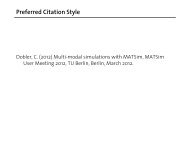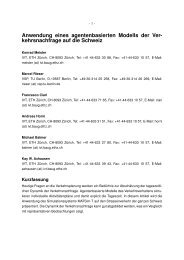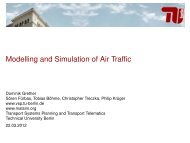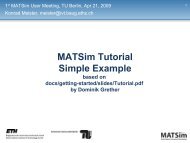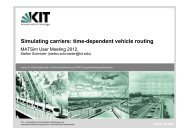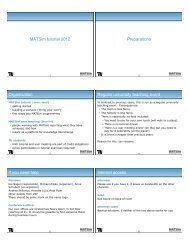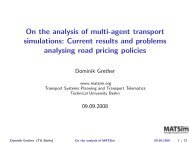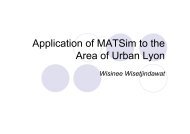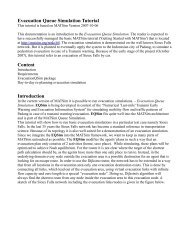User's Guide.pdf - MATSim
User's Guide.pdf - MATSim
User's Guide.pdf - MATSim
Create successful ePaper yourself
Turn your PDF publications into a flip-book with our unique Google optimized e-Paper software.
which decreases with increasing t_x. This means that activities with larger typical duration are easier to drop completely.In the end, this makes sense: Since the additional score of any activity is the same, the score per time is smallest for activities with longtypical durations. Therefore, it makes sense to drop them first.But practically, this is probably not desired behavior, since it would first drop the home activity from a daily plan.Overall, therefore: In my opinion, the current utility function does not work for activity dropping.An alternative, never tested since activity dropping was never tested with this utl fct, would to to recognize that U'(t_0) = beta * t_x / t_0 ,i.e. increasing slope with decreasing t_0. That is, high priority activities should have t_0 such that t_x/t_0 is large (large slope = hard todrop). Activities of the same priority should have t_0 such that t_x/t_0 is the same between those activities. Overall, something likeweight \propto t_x/t_0ort_0 \propto t_x/weightwhere large weight implies a large importance of the activity.This was, as said, never tried, since activity dropping was never systematically tried. It also does not fix the problem, discussed later, thatdifferent activities might have different resistance against making them shorter; since this is U'', this is -beta/t_x with the above utl fct:activities are shortened proportional to their typical duration.To make matters worse, there is currently the convention that negative values of U are set to zero. This is done since we need useablevalues for negative durations (since they may happen at the "stitching together" of the last to the first activity of a day), and if we give thosea "very negative" score, then the utl at t=0 cannot be even smaller than this.This has, however, the unfortunate consequence that the "drift direction" of the adaptive algorithm, once an activity duration has gonebelow t_0, goes to zero duration.Outlook: What would we want for our next generation utl function? Some wishes from my perspective:Curvature at typical duration can be calibratedSlope at U=0 can be calibratedUtl function extends in meaningful way to negative durations (this would fix the arbitrary handling that we currently employ)In my view, a polynomial of second degree would be worth trying. As usual, there are several ways to set this up. One way is to expandaround the typical duration:U(t_x + eps) = U(t_x) + eps * U'(t_x) + eps^2 * U''(t_x)/2orU(x) = U(t_x) + (x-t_x) * U'(t_x) + (x-t_x)^2 * U''(t_x)/2with t_x = typical duration, U'(t_x) = beta = marg utl at typ dur, U''(t_x) = curvature at typ dur ("priority"), and U(t_x) = "base value ofact" (which could be something like beta*t_x ).Another way (having the parabola going through (0,0)) would beU(x) = - a x ( x - c ) = - a x^2 + a c xU'(x) = - 2 a x + a cprio = U'(x=0) = a c , i.e. c = prio/a .beta = U'(x=t_x) = - 2 a t_x + prio, i.e. a = (prio - beta)/2t_xThere is other work (e.g. by Joh) that should be looked at.



